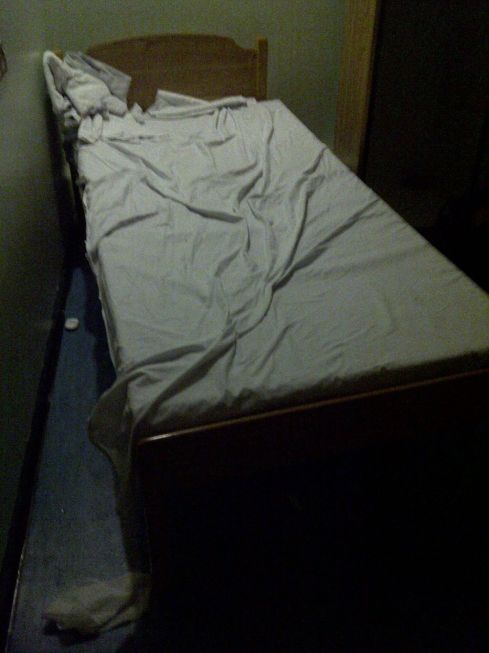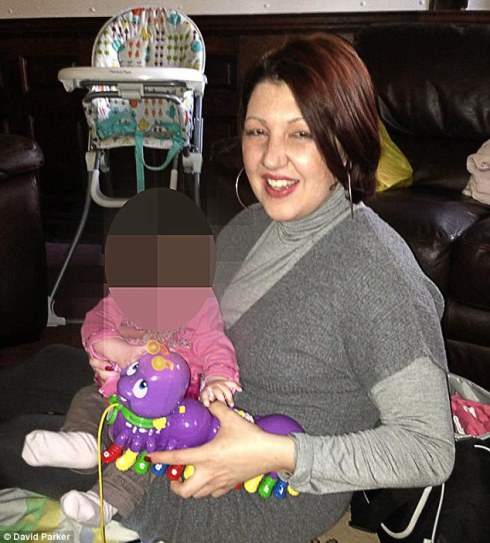

Looking at a newspaper story about the murder of drummer Lee Rigby earlier in the year, Lloyd, who has a diagnosis of paranoid schizophrenia, said that hearing about schizophrenics in the news made him feel worse. He worried that he didn’t know his own mind and wondered if he himself could turn into a murderer too, since that’s what he read in the papers. Dealing with the symptoms of psychosis can be difficult enough in itself. Having to deal with society’s perceptions that people with your diagnosis are violent and unpredictable adds another level of difficulty.
Earlier today, I attended an advance screening of Channel 4’s new series on the realities of modern mental health care at the South London and Maudsley (SLaM) mental health trust. In the screening room in the basement of Channel 4′s headquarters in Horseferry Road, a select audience sat in red plush seats watching one of four programmes in the series on modern mental health care. The series is entitled Bedlam and the name choice has caused controversy. To an extent it can be argued that, when a respected NHS trust calls a television series after a medieval asylum, it dilutes the strength of the case against Thorpe Park’s “mental patient scary fun” horror maze Asylum. But what of the series itself?
The episode previewed profiled the work of Speedwell community mental health team (CMHT) in Deptford, south London, over the course of a year. The four-part series, which starts at 9pm this Thursday, also covers the Anxiety Disorders Residential Unit, Lambeth Triage (the front line for emergency cases) and the older adults unit (over 65s).
Without giving too much away, we followed patients Tamara, Lloyd and Rosemary, all of whom experience psychosis. We saw them trying to cope with periods of illness, voices, delusional beliefs about bed bugs and with children being taken into foster care. We saw them using prescription drugs as well as speed and alcohol to help manage their troubling symptoms. We saw them at times chaotic and disturbed, and at other times funny and happy.
We saw social worker Jim Thurkle doing his best to hunt down and help patients, a third of whom refuse to engage with him. We saw Dr Tom Werner doing his best to confirm the stereotype of the psychiatrist in the bow tie. We saw the fine line between enabling someone to live the life they choose and intervening in the interests of their own health and safety.
Not once did we see someone who could be considered a danger to anyone else. Not once did any of the patients present as anywhere remotely near the stereotype of the paranoid schizophrenic mad axe murderer. What we saw was patients struggling to manage their lives in difficult circumstances, and the professionals who tried to help them.
It was particularly interesting to see the work of a CMHT which, along with GPs, carry out the bulk of psychiatric care in this country. As the booklet handed out at the advance screening says:
“The lion’s share of SLaM’s work takes place in a community setting, looking after more than 35,000 people with mental health issues. SLaM treats 8,000 psychosis patients a year; 6,000 of whom are based and treated in the community. We touch on different treatments available and see intense and moving interaction with social workers and mental health teams.”
As Pete Beard, the producer of the episode, who answered questions after the screening, said:
“We wanted to reflect the realities of this challenging work, following the actual narratives of people walking a tightrope with their mental health as it happened and the teams who act as a safety net. I feel that these realities are rarely reflected accurately in the media and as a result it is important to demystify the work performed as community teams, especially taboo subjects such as being sectioned”.
It was profoundly moving to see someone taken away from their own home, against their will, and detained with no legal authority other than the personal opinions of a social worker and doctors. No police arrest, no court process, no judge, no jury. Just a simple form signed, and you have no choice about even the simplest things like what you eat, where you sleep or what shampoo you use to wash your hair. And, on a more intrusive level, you have no right to refuse medication.
This extended scene cannot help but make you reflect on the balance of power between the state and the individual, and on what society deems to be acceptable norms of behaviour. This is especially so when you’re dealing with someone you don’t really know, as can be the case when a mental health team is called out to consider sectioning someone. Britain has a proud tradition of eccentricity, but that is not tolerated if you are deemed to be mentally ill. Simply being a nuisance to others but in no way dangerous to yourself or others can, ultimately, mean three people decide on your behalf that your quality of life will be improved by a compulsory stay in a locked psychiatric ward.
The sectioning sequence made me think about the boundaries or free will and autonomy and to what extent people’s peculiarities are tolerated. I have been on the receiving end of such a process, and it changed my life irrevocably. As Dr Baggaley said, when he’s taken part in sectionings he does wonder whether this was what he trained for. Although he sees it as difficult, he does see it as necessary.
Dr Baggaley described the person in question as a “revolving door patient” who would face repeated hospitalisations, some under section (compulsion), for the rest of their life. And yet this is someone who will – under the current welfare benefits system – also face repeated Work Capability Assessments. It is hard to see the point of such assessments in this case particularly since, as Dr Sarah Wollaston MP wrote today, WCA’s are not geared towards helping people with mental health problems find and retain employment.
One of the things which struck me in this episode was the amount of humour. Despite their difficult circumstances and troubling symptoms, the patients followed could come across as affable, amenable and warm-hearted. Ripples of laughter would regularly rumble across the audience, and not just because viewers were looking for a little light relief in what was, after all, a serious topic. As with any other fly-on-the-wall documentary, the colourful charaters in this episode were full of humour. The seriousness of the subject matter made the flashes of levity even more welcome.
Overall, this preview episode was intimate, insightful and profound. It showed human beings in all our difficulties, complexities and ambiguities. It showed the realities of trying to combat the stigma around mental illness with humanity and humour. It showed that danger and fear are the least of the concerns of the CMHT.
On a final note, I will end with a criticism that was raised by audience members with personal experience of mental health services: namely that the episode was somewhat naive and unrealistic. Audience members had received far worse experiences of mental health care, or had been able to deliver a far worse service due to cutbacks. It was acknowledged by the film makers that Speedwell CMHT had a ring-fenced budget, so had not been under the same constraints and workload other CMHT’s they’d liaised with had.
It was also highlighted that a lot of the difficulties patients needed help with were practical, and that these needs were not being met. The patients were unable to deal with these matters themselves and therefore they were stuck in difficult circumstances. Examples were the bedbugs which did actually exist in Tamara’s flat. It was not a delusional belief (though its extent may have been) and dealing with that practical problem may have lessened her delusional symptoms. This and her use of amphetamines may also have been the way she managed the immense sorrow of losing her children. Lloyd appeared to be using alcohol to numb his pain.
With a series planned over two years and filmed over twelve months, much footage will have ended up on the cutting room floor. It’s a shame, however, that the close relationship between medical help and social support, and the parts played by talking therapies and thereapeutic activities, were overlooked completely in this preview episode.
Nor was the 9% reduction in inpatient beds in the past 2 years mentioned. Nor were the terrible cuts to community mental health services mentioned.
On the other hand, as Madeliene Long, SLaM chair said:
“Despite it affecting so many people, mental illness is still poorly understood. The stigma and discrimination that people face can make their mental health even worse and can prevent them from seeking help. So it’s really important that we do everything we can to raise awareness, challenge stereotypes and promote the facts about mental health. I’m really pleased that we have been able to work with Channel 4 and The Garden Productions on such an ambitious project which sets out to do exactly that.”
As executive producer Amy Flanagan said,
“Many of these patients had lived long lives with no history of mental illness. It could happen to our parents, to us.”
And, if it does happen to us or someone we know, programmes such as these will mean it feels a little less alien and a little more a part of everyday life.
.
.

.
..
..
Media coverage:
- Channel 4 – press release about Bedlam
- Anxiety (Episode 1/4) – 9pm Thursday 31st October – “It’s a condition every one of us experiences from time to time, but imagine if one day you woke up and found your anxiety had spiralled completely out of control.”
- Crisis (Episode 2/4) – 9pm Thursday 7th November – “At Lambeth Hospital in south London, the Trust has pioneered the use of short-stay emergency wards for patients in crisis. It’s effectively run like A&E but for those with mental illness.”
- Psychosis (Episode 3/4) – 9pm Thursday 14th November – “In this episode we explore the world of the mentally ill who live in the community.”
-
Breakdown (Episode 4/4) – 9pm Thursday 21st November – “In the final episode of Bedlam, cameras gain access to a psychiatric ward for over 65s at the South London and Maudsley (SLaM).”
.
South London & Maudsley NHS Trust:
.
People involved:
- Dan Charlton – Head off communications & media at SLaM (twitter @Dan_Charlton1)
- Dr Tom Werner (twitter @TellDrTom) – psychiatrist & CBT therapist – website
.
Blogosphere
.
.
Related coverage:
.
.
Tags: anxiety, Atos, crime, discrimination, humour, law, medication, Mental health, murder, myths, NHS, prejudice, psychiatric wards, psychiatrists, psychiatry, psychology, schizophrenia, stigma
















